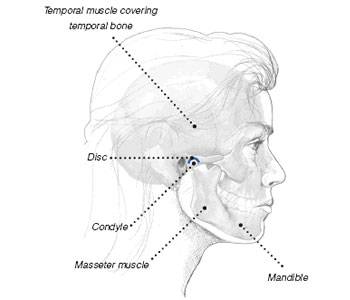Temporomandibular Disorder (TMD)
Overview
Temporomandibular disorder (TMD) is a broad term describing the dysfunction of the temporomandibular joint (TMJ), the associated muscles, and teeth. Approximately 10 million Americans are affected by TMD, and women are more likely to suffer than men.
TMD can be difficult to treat depending on the cause and damage inflicted. One technique to address TMD is through the use of neuromuscular dentistry. Neuromuscular dentistry can reduce the strain and inflammation that builds up between the joint, muscles, and teeth thereby relieving the symptoms of TMD.
Learn more about neuromuscular dentistry and how it can help your TMD by contacting our Scottsdale dentist at Reimage Dental Studio today.
Temporomandibular Joint (TMJ)

The temporomandibular joint (TMJ) is one of the most complex joints in the body. It acts like a sliding hinge connecting the lower jaw (mandible) to the skull. The facial muscles hold this joint in place. A cartilage disk between the jaw and the skull allows for a wide range of motion. This range of motion allows for talking, eating, and even breathing.
The TMJ and the associated muscles are in constant motion and must accommodate the teeth, with the wear and shifting that occur over a lifetime. When this complex system of muscles and the TMJ is misaligned or strained, discomfort and pain can result.
Symptoms of TMD
Temporomandibular disorders (TMD) can have a range of signs and symptoms, ranging from mild to severe. Pain in the TMJ is the most apparent symptom; other symptoms may include:
- Head Pain – forehead, temples, migraine headaches
- Eyes – pain behind the eyes, sensitivity to sunlight
- Mouth – discomfort, limited opening of mouth, jaw deviates to one side
- Teeth – clenching, grinding, worn teeth, sensitivity, lose or sore back teeth
- Jaw Problems – clicking, popping, pain in cheek muscles
- Neck Problems – pain, lack of mobility, shoulder or back pain
Causes
Trauma to the temporomandibular joint can play a role in TMD; however, some people experience pain or soreness without this trauma. The exact causes of TMD are not fully understood, but people have had significant success in reducing or eliminating TMD through neuromuscular dentistry.
Diagnosis
Dr. Call and his team use modern state-of-the-art technology and procedures to help diagnose temporomandibular disorders (TMD). To help determine the optimal physiological position of the muscles and joints, Dr. Call uses the following technology to gain a clear image of your situation.
- A TENS (Transcutaneous Electrical Nerve Stimulation) unit is utilized to provide relaxing stimulation to the muscles of the face and neck. The TENS unit helps to relax and erase abnormal muscle movements. Once the muscles are relaxed, the TMJ can find its optimal alignment, and the patient’s bite is checked for misalignment or interference with optimal joint and muscle movement.
- An EMG (electromyography) monitor is used to detect muscle strain in each of the eight different muscles responsible for jaw movement and positioning. While the EMG is monitoring, the bite is examined, and adjustments are made to remove the strain between the teeth, TMJ, and facial muscles.
- An Electrognathograph is used to track the lower jaw (mandible) movements to help recognize deviation in jaw movement. These deviations can indicate damage to the joint or cartilage disk.
- A 3-Dimensional CT scanner is used to gain an image of the TMJ to help determine the proper joint position. With this 3D image, the TMJ can be visualized for the ideal position between the mandible, skull, and cartilage disk.
Treatment
Once the optimal position is found during diagnosis, initial treatment begins with the fabrication of bite splints or orthotics. These devices help patients maintain the optimal position, while they sleep, and allow for the healing of the facial muscles and the TMJ. With a reduction in strain and inflammation, the patient can expect to see improvement in their pain and other symptoms. As the symptoms are relieved the ideal relationship between the teeth, TMJ, and facial muscles is determined. Definitive treatment can be completed using orthodontics or restorations to align the teeth with the TMJ for long-term results.
Contact Reimage Dental Studio to learn more about neuromuscular dentistry and how it can help improve or eliminate your TMD/TMJ. Schedule an appointment today.
